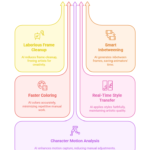Tariffs on US imports in 2025 are set to reshape the budgets of middle-class households. With a universal 10% tariff on all goods entering the country, plus higher rates like 34% in China and 25% in Mexico and Canada, everyday purchases will cost more. The only question left is who will pay the tariffs and who will change their shopping and consumer behaviors to domestic items or no purchase at all.
This post explores the top 10 items middle-class families rely on that will feel the biggest pinch, based on current trade policies as of April 7, 2025, that are going into effect soon. From cars to coffee, each section explains why these goods are hit hard, how tariffs disrupt their supply chains, and what the price increases mean for you.
1. Cars and Auto Parts
Owning a car is a cornerstone of middle-class life, with most families depending on vehicles for work and school. Tariffs are driving up costs, with a 25% rate on auto parts from Mexico and Canada starting April 2, 2025, layered with a 10% universal tariff.
Exemptions under the USMCA trade deal are postponed until May 3, 2025, leaving supply chains subject to higher tariff costs. Economists project lower-cost models could rise by $2,500 to $5,000, while imported cars might jump $20,000. For a family replacing a sedan, this could stretch finances thin, making commuting and road trips pricier.
2. Electronics (Smartphones, Laptops, TVs)
Smartphones and TVs are staples in middle-class homes, essential for communication, work, and entertainment. A 34% tariff on China, reciprocal tariffs up to 34% on key exporters, and a 10% universal tariff target these goods’ origins.
Most electronics come from Asia, where these rates hit hard. Analysts estimate prices could climb 10% to 20%, meaning a $1,000 laptop might cost $1,100 to $1,200. An iPhone priced at $799 could rise to $959. For families upgrading devices or equipping kids for school, these increases add up, turning routine purchases into budget challenges.
3. Clothing and Footwear
Clothing and shoes are non-negotiable expenses for middle-class households, dressing kids and adults alike. With a 34% tariff on China, 46% on Vietnam, 37% on Bangladesh, and a 10% universal tariff, the cost of imports from these major suppliers spikes.
Stores like Walmart and Target, where families shop, will pass these costs on. Experts suggest footwear alone could add $6.4 billion to $10.7 billion annually to US spending. A $50 pair of sneakers might rise to $57-$60, pushing a family’s yearly clothing budget up by 5%-10%, or $97 to $194.
4. Fresh Produce (Avocados, Vegetables, Fruits)
Fresh produce keeps middle-class kitchens running, from salads to snacks. Mexico, supplying 60% of US vegetables, faces a 25% tariff, partially delayed for USMCA goods until April 2, 2025. Latin American exporters like Brazil and Colombia see a 10% universal tariff.
This disrupts affordable supply lines, with grocery bills projected to rise $435 per family yearly from Mexican imports alone. Avocados at $1.50 each could hit $1.88, making healthy eating costlier. For households prioritizing nutrition, these small hikes compound into a noticeable strain.
5. Gasoline and Energy Costs
Driving to work or heating homes defines middle-class life, especially in sprawling suburbs. Canada, providing 40% of US crude oil, faces a 10% tariff on energy products, distinct from the 25% on other goods. This affects gas stations and utilities, particularly in the Midwest.
Projections show gas prices rising 10-40 cents per gallon, turning $3.50 into $3.90. Annual heating costs could climb from $50 to $100 per household. For families juggling commutes and winter bills, these tariffs squeeze an already tight budget, forcing tough choices. The recent two-day plunge of -15% in oil prices will help offset much of this tariff as energy is currently experiencing spiraling deflation.
6. Furniture
Home furnishings for middle-class families are already becoming more expensive as some retailers are repricing their merchandise based on future restocking costs. A 34% tariff on China, 46% on Vietnam, and a 10% universal tariff target their top furniture exporters.
As a result, prices are expected to rise 15-20%. A $500 sofa could cost $575 to $600, adding hundreds to a room refresh. This hits young couples or downsizing retirees hardest, delaying plans to settle comfortably. With furniture already a big-ticket item, these tariffs make creating a home feel less attainable.
7. Household Appliances (Washing Machines, Refrigerators)
Appliances like washers and fridges are vital for middle-class households, keeping daily life on track. A 34% tariff on China, 25% on Mexico, and a 10% universal tariff drive up costs from these key manufacturers.
Past tariffs in 2018 raised washer prices by $86 per unit, and now experts predict $100 to $200 more per appliance. A $600 refrigerator might jump to $720. When an old machine breaks, replacing it becomes a financial hurdle, testing the resilience of families already stretched by other rising costs.
8. Construction Materials (Lumber, Drywall)
Home repairs and renovations are standard for middle-class homeowners aiming to maintain or improve their properties. Canada, supplying over 70% of US lumber, and Mexico, a key gypsum source, face a 25% tariff.
This pushes construction costs, with projects potentially costing over $1,200 each. A $5,000 kitchen remodel could balloon to $6,200. For the 63% of homeowners tackling upgrades, these tariffs turn affordable fixes into daunting expenses, leaving houses unfinished or budgets overstretched.
9. Toys and Sporting Goods
From holiday gifts to team practices, toys, and sports gear bring joy and activity to middle-class kids. A 34% tariff on China, the dominant supplier, plus a 10% universal tariff, lifts prices by 10% to 15%.
A $50 Lego set might rise to $57 or $58, while a soccer ball could cost an extra $5. Families spending $300 yearly on these items face an additional $30 to $45. With kids’ happiness and fitness at stake, these tariffs chip away at discretionary funds, making playtime less carefree.
10. Coffee and Chocolate
Coffee and chocolate are small luxuries middle-class households enjoy daily, fueling mornings and sweetening evenings. A 10% universal tariff on Brazil and Colombia, plus 21% on Cote d’Ivoire for cocoa, nudge prices up 5%-10%.
A $10 coffee bag might hit $10.50 to $11, adding $20 to $50 yearly to grocery bills. With 62% of Americans sipping coffee daily, these modest hikes ripple through budgets. Though less dramatic than car costs, they still erode the comfort of routine treats, testing financial flexibility.
Conclusion
Tariffs in 2025 will touch nearly every corner of middle-class life, from driving to dressing, eating to entertaining. The universal 10% rate, combined with steeper tariffs on major trading partners, lifts the cost of goods families can easily avoid.
At the same time, some increases seem small, like a few cents on coffee, while others, like thousands on a car, hit hard. Depending on habits, they could add $1,700 to $3,000 to a household’s annual expenses. Navigating these changes will demand smarter shopping and brutal trade-offs as trade policies reshape the middle-class wallet. It will take years in many cases to move supply chains into the US to avoid many of these tariffs.





